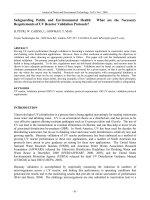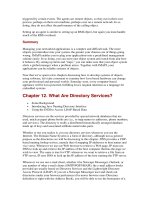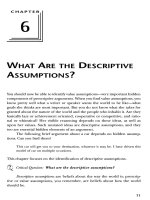What Are Directory Services
Bạn đang xem bản rút gọn của tài liệu. Xem và tải ngay bản đầy đủ của tài liệu tại đây (129.12 KB, 14 trang )
triggered by certain events. The agents are remote objects, so they run in their own
process, perhaps on their own machine, perhaps even on a remote network. In so
doing, they do not affect the performance of the calling object.
Setting up an agent is similar to setting up an RMI object, but again you must handle
much of the RMI overhead.
Summary
Managing your networked applications is a complex and difficult task. The more
objects you introduce into your system, the greater your chances are of things going
wrong. JMAPI enables you to plug your applications into a predefined management
scheme easily. In so doing, you can start your object system and watch from afar how
it behaves. By setting up alerts and "traps," you can make sure that your object system
alerts a global manager when a problem arises. Together with JMAPI, your
applications can be reliable systems of objects.
Now that we've spent a few chapters discussing how to develop systems of objects
using software, let's take a moment to examine how Java-based hardware can change
your professional and personal worlds. Someday soon, every computer-based
appliance will be Java-powered, fulfilling Java's original intention as a language for
embedded systems.
Chapter 12. What Are Directory Services?
•
Some Background
•
Introducing Java Naming Directory Interface
•
Using the JNDI to Access LDAP-Based Data
Directory services are the services provided by special network databases that are
used, much as paper phone books are (i.e., to map names to addresses, phone numbers,
and services). The directory is really a distributed hierarchically arranged database
made up of keys and associated attribute name/value pairs.
Whether or not you realize it, you use directory services whenever you use the
Internet. The Domain Name System is a form of directory, although not as general
purpose as the directories we will be discussing in this chapter. DNS provides a UDP-
based naming lookup service, namely that of mapping IP addresses to host names and
vice versa. Whenever we use our Web browser to retrieve a Web page, IP must use
DNS to look up and retrieve the IP address of the host computer that has the page we
wish to view. The same is true for FTP: whenever we want to retrieve a file from an
FTP server, IP uses DNS to look up the IP address of the host running the FTP server.
Whenever we use our e-mail client, whether it be Netscape Messenger, Outlook, or
any number of other e-mail clients (SMTP/POP3/MAPI), the e-mail address books
provided are usually based on Directory Services and the Lightweight Directory
Access Protocol (LDAP). If you are a Netscape Messenger user and check out
directories under your browser preferences (for newer browser users Directory
definition is right with the Address Book), you will be able to see the hostnames of a
number of commercial directories that allow general access to the public. If you then
select your personal address book, export (under the file drop-down menu) it to a file,
and then use Notepad or Wordpad to view it, you will notice that each entry is keyed
by a set of tags. You should see the dn: tag followed by a set of name/value attributes.
Files in this form are in a format known as LDAP Data Interchange Format (LDIF).
This file format is used for the batch process loading (and backing up) of Directory
Servers. The LDIF file itself is usually populated with information from other data
sources (possibly your company's Human Resources Database, the Userid/password
database for your Local Area Network, or data extracted from a relational database
that keeps track of the hardware configuration of all the workstations in your site and
is used via Directory Services by your local helpdesk).
Currently the two most popular uses of directory servers are for user authentication
(by userid and password) for accessing limited access Web pages/sites and as e-mail
address books for intranet-based address books (for a corporation) and by the large
ISPs as address books for their users. In the near future, a big user of directory servers
will be e-Commerce applications using the Enterprise Java Beans framework because
directory servers are extremely fast. As a special-purpose database, they provide an
ideal mechanism for giving persistence to Java objects.
Some Background
The concept and architecture of modern directory services comes to us from the ISO
X.500 specification for directory services.
A directory is intended to be a hierarchically arranged database; arrangement of the
database is left up to the designer of the Directory Information Tree (DIT). The DIT
of a multinational corporation could be arranged a number of ways. It could be
arranged hierarchically by geographic location as in Figure 12-1 or by organizational
function as in Figure 12-2.
Figure 12-1. Distinguished name structure by geographic location.
Figure 12-2. Distinguished name structure by organizational function.
Every directory entry is uniquely identified by an ordered sequence of name/value
attributes. The ordering of the attributes is such that it reflects the hierarchical
relationship that exists between the attributes. Assume the following naming attributes:
Attr. Name Meaning
c Country
o Organization
ou Organizational Unit
cn Common Name
If we use the concatenation of these attributes and their values to identify an entry in
the directory, we have defined the entry's distinguished name. Distinguished names
are unique, much like the primary key in a relational database table. My distinguished
name using the preceding schema would be
{C=US, O=SUNY, OU=Binghamton, CN=Dick Steflik}
Figure 12-1 shows this pictorially.
Each node in the tree structure has a distinguished name made up of the list of
attributes up to and including that node. The distinguished name for Binghamton
University would be
{ dn: ou=binghamton, o=suny, c=us}
X.500 defines the directory service as an object (see Figure 12-2), accessed through a
set of service ports. Each port is intended to provide access to a specific set of services.
Three of the primary service ports defined early in the X.500 development are:
1. Read Port provides the ability to read information from a directory.
2. Search Port provides the ability to search and list directory information.
3. Modify Port provides the ability to add, modify, and delete directory entries.
To support these service ports, the DAP has a very comprehensive set of protocol-
based operations that address all the facilities needed to create and maintain a large
distributed directory.
For applications that are directory-oriented but of a scale smaller than what X.500 and
DAP were designed for, applications like address books for Web browsers,
authentication for Web pages, a lighterweight version of the DAP has been developed.
This slimmed down version of DAP is named Lightweight Directory Access Protocol
or LDAP for short. LDAP is described in RFC 2251 as an access mechanism to X.500
directories. It is a language-independent description of the protocol operations
required to interact with an X.500 directory.
Introducing Java Naming Directory Interface
The architecture of Java Naming and Directory Interface (JNDI) is a Java-specific
architecture for accessing a number of directory-based data repositories including
LDAP. The Java Interface to LDAP is only one of a number of services provided
through the JNDI architectural model shown in Figure 12-3.
Figure 12-3. JNDI architecture.
If we re-examine the architectural picture of JDBC in Chapter 4
, we can see some
very real similarities. In Figure 12-3, if we replace "JNDI" with "JDBC," "Service
Provider Interface" with "Driver Manager," and "CORBA, NDS, NIS, LDAP, DNS,
RMI" with words like "DB2, Oracle, Access, Sybase," we essentially have the same
picture. The architecture is essentially the same after all; directories are really just
special-purpose databases, and for each database (datasource) there is a driver or
service provider.
The main difference between directories and relational databases is that the directory
information model is hierarchical, whereas, the model for relational databases is a set
of tables. Relational databases are much more general purpose than directories;
because directories are special-purpose, their data model can be tailored to their
special-purpose uses. This can make them extremely fast for the types of queries done
against them, much faster than the equivalent query using a relational database.
Using the JNDI to Access LDAP-Based Data
The Netscape Directory server comes with a sample LDIF file for the Airius
Corporation that can be imported to set a reasonably sized and typically set up
database. We'll use this directory to demonstrate the major LDAP features.
Setting up the Airius Directory
To start this exercise, go to the Netscape download site for server software and
download a trial copy of the Directory Server. This will get you a 30–60 day copy of
the world's best Directory Server (yes, I am a little biased). This won't run on
W95/W98 so make sure to download a copy for the appropriate platform you want to
run the service on.
Using the Netscape Admin Interface, turn off the instance of the Directory Server that
you wish to install Airius on. (In Netscape Suite Spot there is a separate Admin server
through which you do all Suite Spot server administration.) Click on the button with
the name of the instance you want to administer. When the page for the Netscape
Directory Server administration is displayed, click the Database Management button
and then click on the Import choice in the left-hand frame. On the Import panel, select









